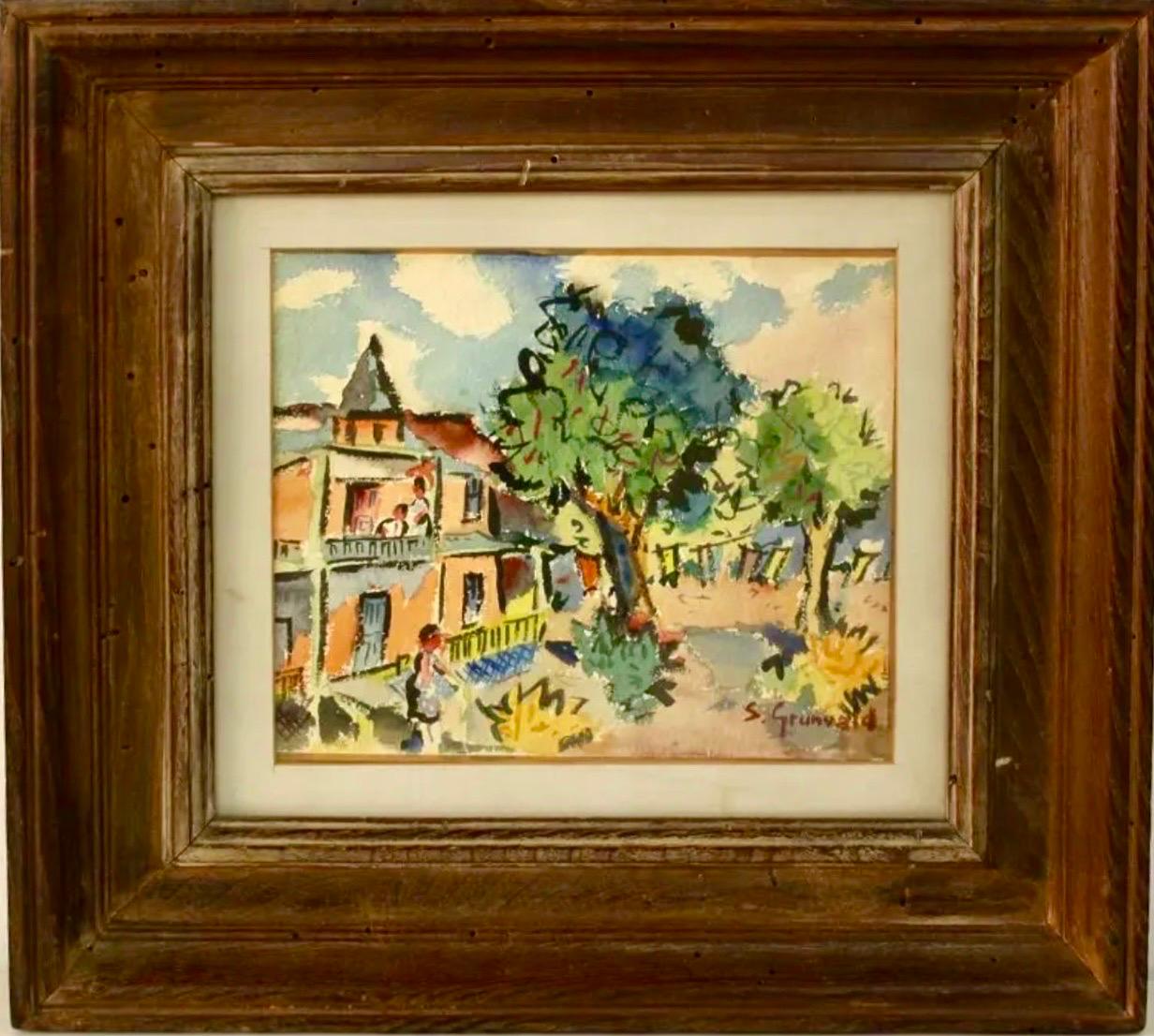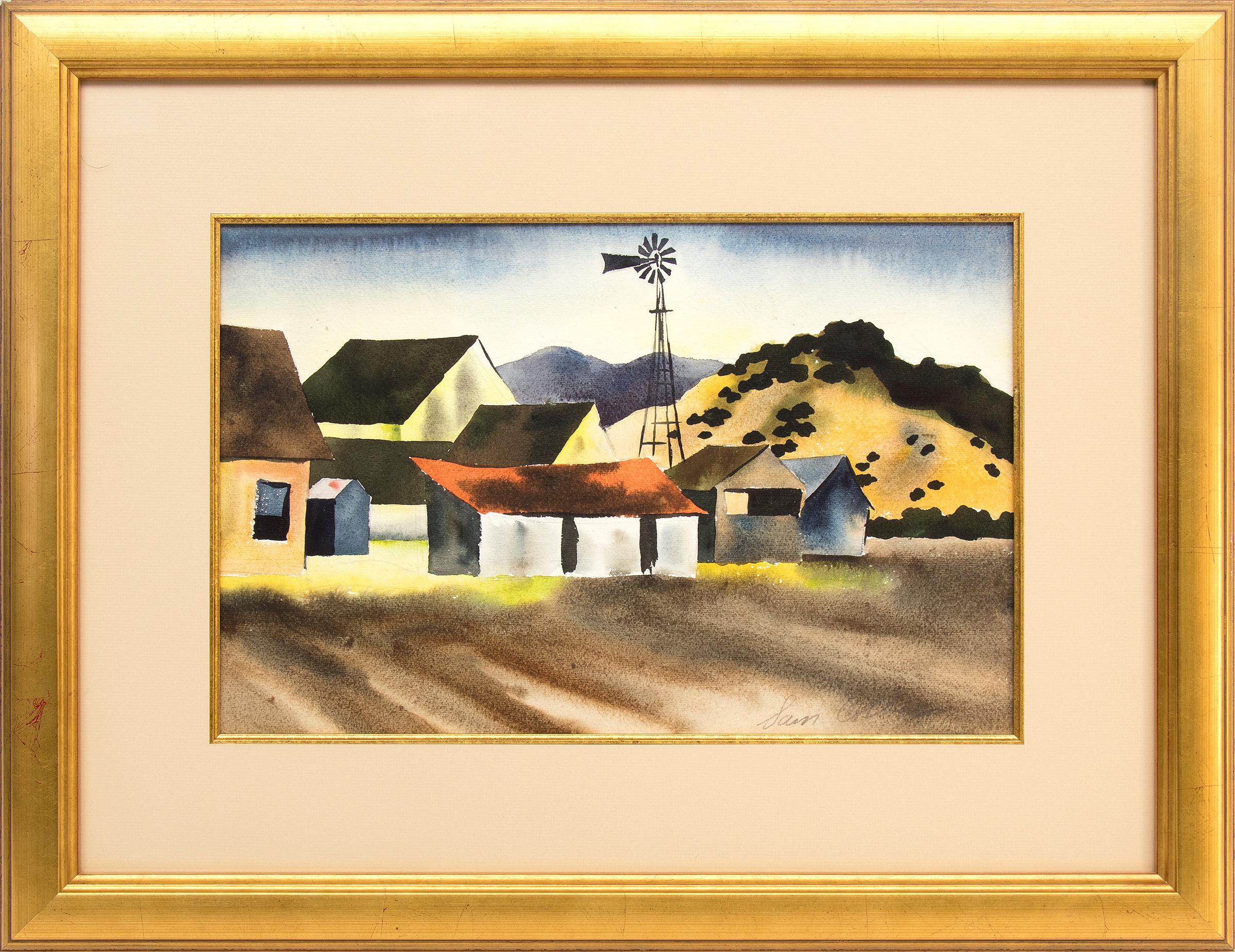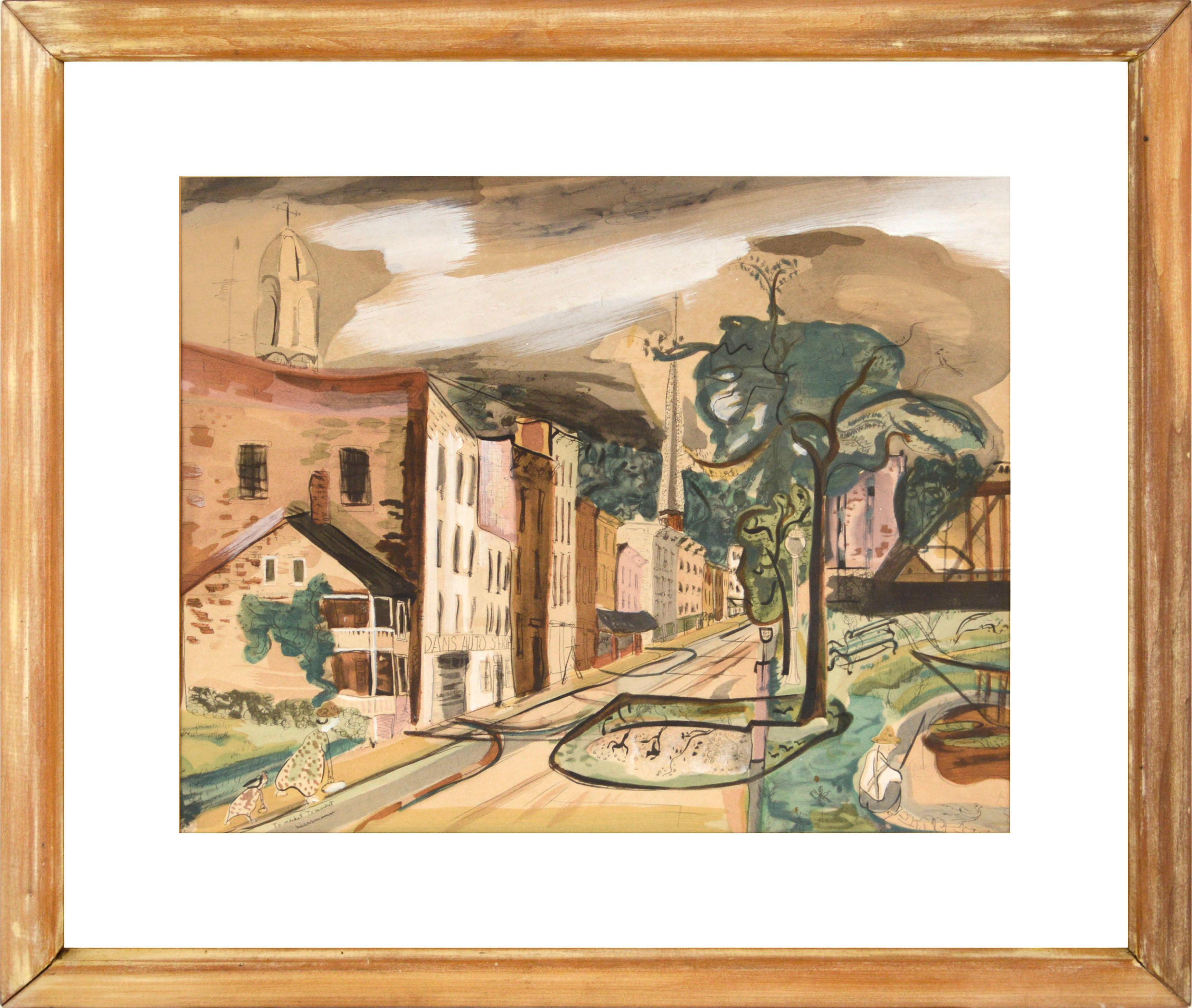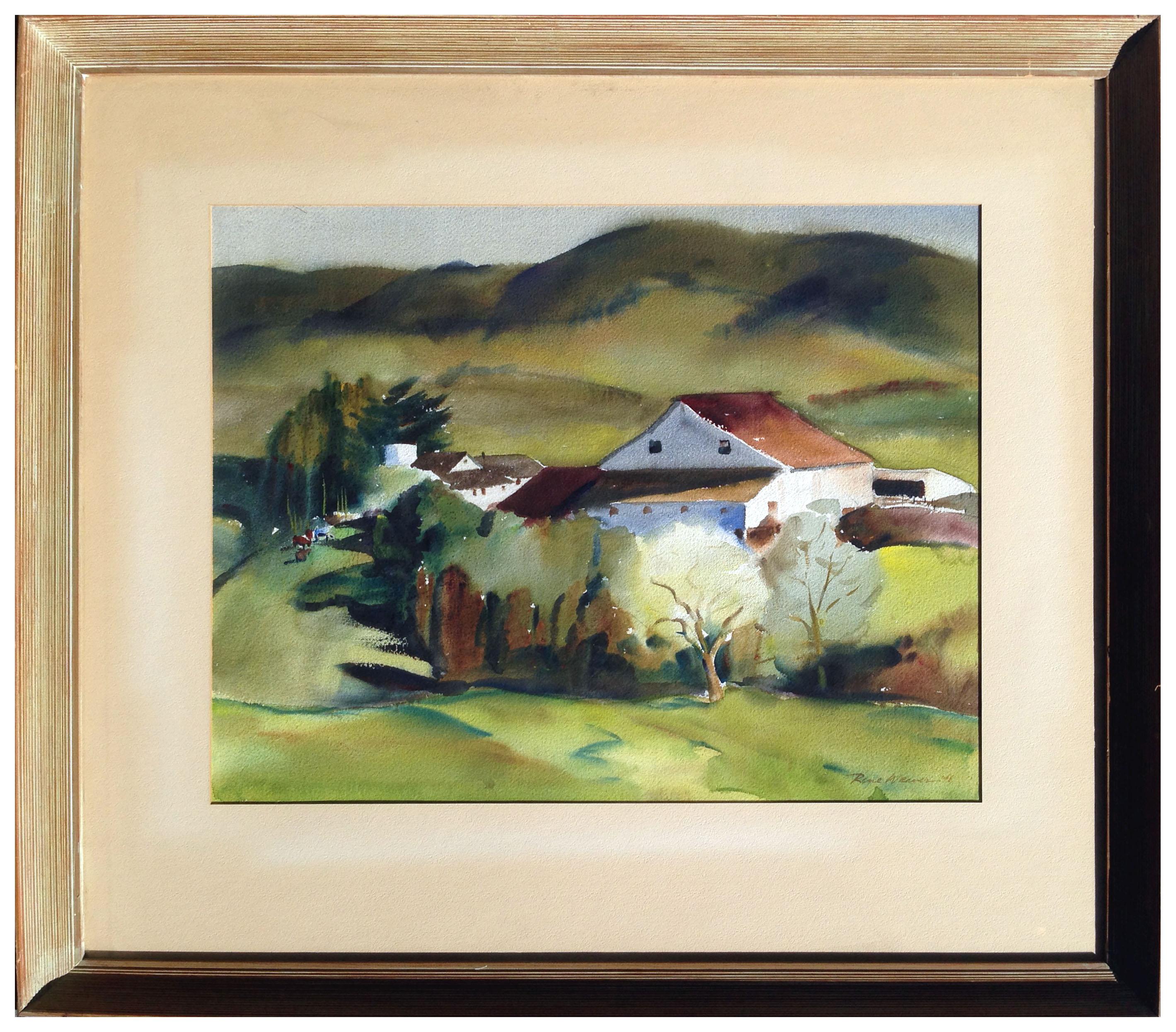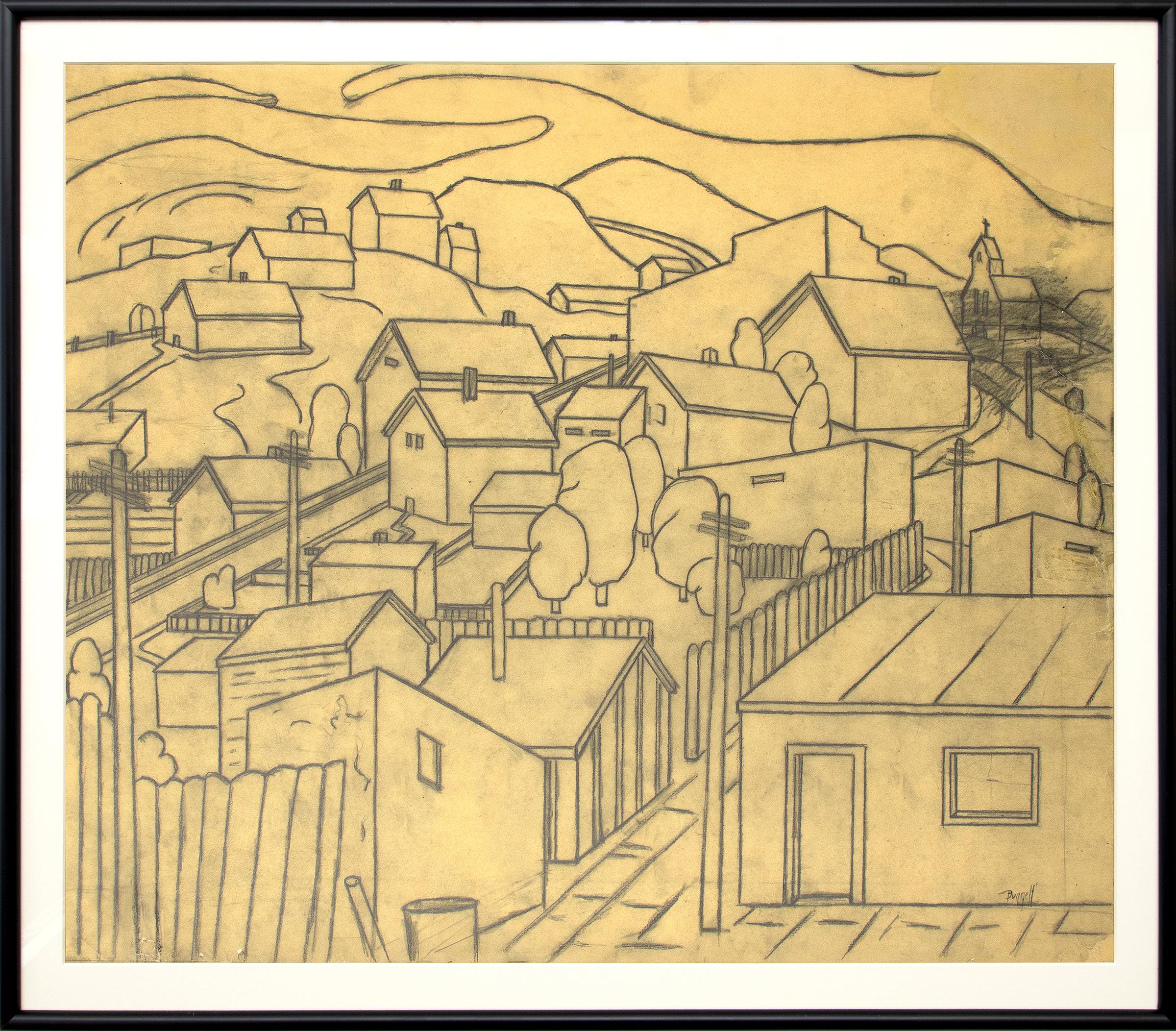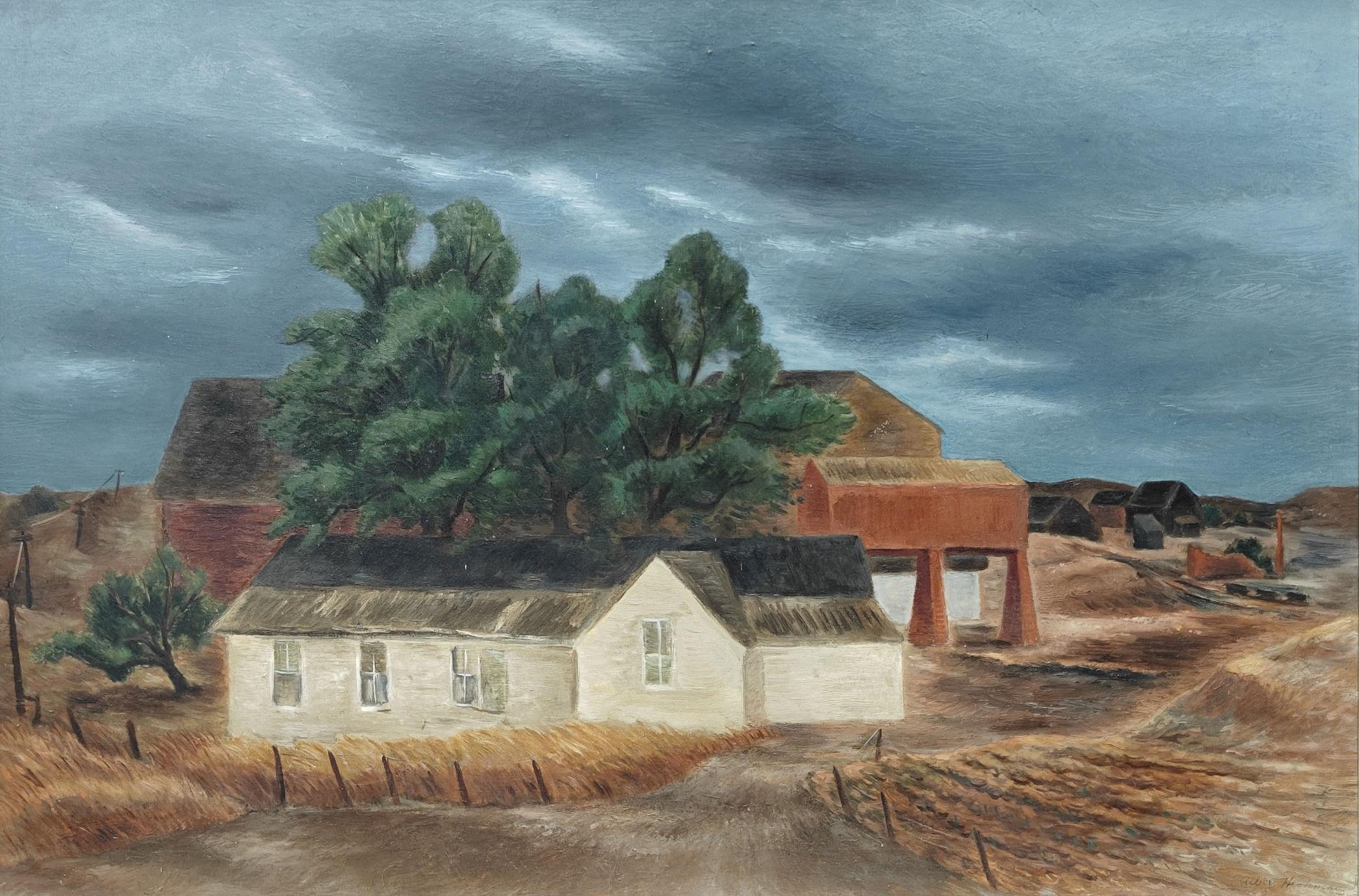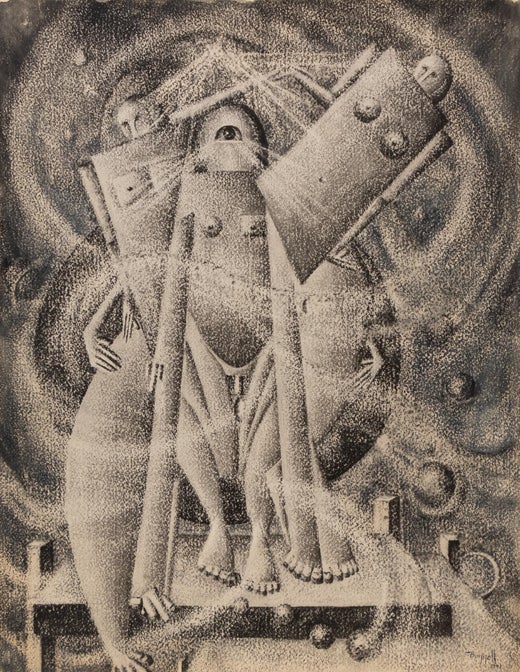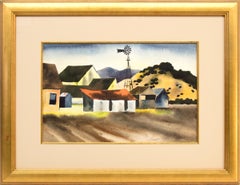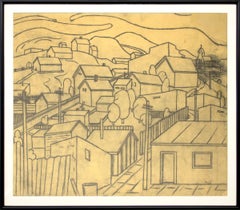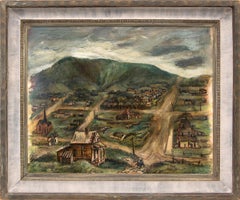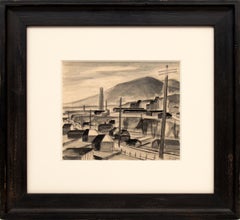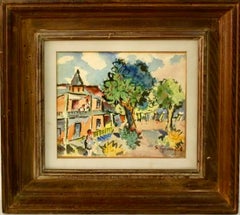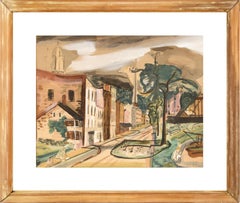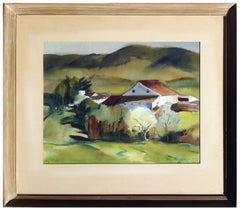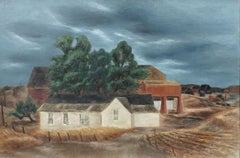Items Similar to WPA 1940s Framed Figurative Village Landscape with Figures, Houses & Mountains
Want more images or videos?
Request additional images or videos from the seller
1 of 15
Charles Ragland BunnellWPA 1940s Framed Figurative Village Landscape with Figures, Houses & Mountains1940
1940
$4,950
$8,25040% Off
£3,722.06
£6,203.4440% Off
€4,303.85
€7,173.0840% Off
CA$6,985.82
CA$11,643.0340% Off
A$7,579.96
A$12,633.2740% Off
CHF 4,021.03
CHF 6,701.7140% Off
MX$93,081.34
MX$155,135.5740% Off
NOK 49,727.07
NOK 82,878.4440% Off
SEK 47,091.47
SEK 78,485.7940% Off
DKK 32,126.44
DKK 53,544.0640% Off
About the Item
This evocative watercolor painting, titled The Way War First Comes (1940), was created by noted American artist Charles Ragland Bunnell (1897-1968) during the Depression era. The piece captures a dramatic outdoor village scene, reflecting Bunnell’s unique ability to intertwine landscape with the broader human experience. The painting is presented in a custom black frame with archival materials to preserve its integrity, with outer dimensions of 26 x 35 ½ x ⅝ inches, and an image size of 15 ¼ x 24 ⅝ inches.
Provenance: Private Collection, Colorado
About the Artist:
Charles Ragland Bunnell, often referred to as “Charlie,” was an American artist whose work spanned multiple styles throughout his career. Known for his versatility, Bunnell believed in constantly evolving his artistic approach, famously stating, “I’ve got to paint a thousand different ways.” His career saw him explore both representational and abstract forms, making him one of the few Colorado artists to incorporate modern trends from New York and Europe after World War II.
Although Bunnell did not receive widespread critical acclaim during his lifetime, his work garnered significant recognition, especially in the late 1940s when his painting Why? was chosen by curator Katherine Kuh for an important exhibition of abstract and surrealist art at the Art Institute of Chicago. His art was featured in traveling shows to ten other American museums, marking a high point in his career.
Born in Kansas City, Bunnell moved to Colorado Springs in 1917, where he would spend the majority of his life. After serving in World War I, Bunnell pursued commercial art and later studied at the Broadmoor Art Academy. His studies with renowned artists like Birger Sandzén and Ernest Lawson influenced his distinctive landscape work. In the 1930s, he began painting Colorado’s mining towns and valleys, contrasting the grandeur of mountain scenery with stark industrial subjects.
Bunnell’s involvement with New Deal art projects, including the Treasury Relief Art Project and Federal Art Project, shaped much of his work during the Great Depression. His early engagement with these programs, especially his murals for Colorado Springs schools, reflects his commitment to the American Scene style.
As the years progressed, Bunnell’s work evolved into more abstract forms, influenced by his personal experiences and the tumultuous events of the time, including the loss of his son and the impact of World War II. His later abstract works, such as the Black and Blue series, were deeply spiritual, drawing on diverse philosophies and offering a window into the artist’s evolving emotional and intellectual journey.
A dedicated teacher, Bunnell continued to mentor younger artists throughout his life, sharing his knowledge and encouraging experimentation. His legacy includes solo exhibitions at prestigious institutions like the Kansas City Art Institute, New Mexico Museum of Art, and the Colorado Springs Fine Arts Center.
Bunnell’s work can be found in major collections across the United States, including the Denver Art Museum, Art Institute of Chicago, and Colorado Springs Fine Arts Center, among others.
- Creator:Charles Ragland Bunnell (1897-1968, American)
- Creation Year:1940
- Dimensions:Height: 26 in (66.04 cm)Width: 35.5 in (90.17 cm)Depth: 0.5 in (1.27 cm)
- Medium:
- Movement & Style:
- Period:
- Framing:Frame IncludedFraming Options Available
- Condition:
- Gallery Location:Denver, CO
- Reference Number:Seller: 258591stDibs: LU27310432072
Charles Ragland Bunnell
Charles Bunnell developed a love for art at a very young age. As a child in Kansas City, Missouri, he spent much of his time drawing. When he was unable to find paper he drew on walls and in the margins of textbooks for which he was often fined. Around 1915, Bunnell moved with his family to Colorado Springs, Colorado. He served in World War I and later used his GI Training to study at the Broadmoor Art Academy (later renamed the Colorado Springs Fine Arts Center) during 1922 and 1923. In 1922, he married fellow student, Laura Palmer. He studied with Ernest Lawson in 1927-1928 and, in the winter of 1928-1929, he served as Lawson’s assistant. In the late 1920’s, the Bunnell’s settled just west of Colorado Springs and 1928, they welcomed the first of their three children. Their one-acre homesite, which they referred to as “Old Home Place”, was situated between two sets of railroad tracks at the foot of Pike’s Peak. Charlie converted an old railroad boxcar into his studio, where he later gave lessons. Beginning in 1931, Bunnell spent a year and a half studying under Boardman Robinson. The two men clashed constantly due to a generation gap and markedly different philosophies. Robinson encouraged his students not to stray from realism and though Bunnell mastered Robinson’s preferred style of American Scene painting, he regularly irritated his professor with his abstract sketches. Bunnell taught at the Kansas City Art Institute during the summers of 1929, 1930, 1940, and 1941. Between 1934 and 1941, he painted and taught under federal projects which included assisting Frank Mechau on murals for the Colorado Springs Post Office. However, he did not take to mural making and, after criticism from Boardman Robinson about his use of “heavy daubs which have no place in mural work,” he abandoned mural-making altogether. By the late 1930’s, Bunnell’s work departed from the American Scene/Modernist style he was trained in towards abstraction. This is marked by his “Black and Blue” series, consisting of 83 abstracted ink and watercolors. Affected by the Second World War and the loss of his 10-year old son, Bunnell’s work of the early 1940’s took on a Transcendental and Surrealist tone. The works from this period are moody and readily reflect the political and personal turmoil experienced by the artist. In the late 1940’s, Bunnell began experimenting with Abstract Expressionism. He alone is credited with introducing Colorado Springs to the new style as it was excluded from the Fine Art Center’s curriculum by Boardman Robinson. Bunnell excelled in Abstract Expressionism and continued to evolve in the style through the 1950’s continuing to his death in 1968. He was recently recognized as a premier American Abstract Expressionist by his inclusion in the book American Abstract Expressionism of the 1950’s: An Illustrated Survey. © David Cook Galleries, LLC
About the Seller
5.0
Gold Seller
Premium sellers maintaining a 4.3+ rating and 24-hour response times
Established in 1979
1stDibs seller since 2013
295 sales on 1stDibs
Typical response time: 4 hours
- ShippingRetrieving quote...Shipping from: Denver, CO
- Return Policy
Authenticity Guarantee
In the unlikely event there’s an issue with an item’s authenticity, contact us within 1 year for a full refund. DetailsMoney-Back Guarantee
If your item is not as described, is damaged in transit, or does not arrive, contact us within 7 days for a full refund. Details24-Hour Cancellation
You have a 24-hour grace period in which to reconsider your purchase, with no questions asked.Vetted Professional Sellers
Our world-class sellers must adhere to strict standards for service and quality, maintaining the integrity of our listings.Price-Match Guarantee
If you find that a seller listed the same item for a lower price elsewhere, we’ll match it.Trusted Global Delivery
Our best-in-class carrier network provides specialized shipping options worldwide, including custom delivery.More From This Seller
View All1930s American Modern Farm Landscape Watercolor with Barns, Windmill & Fields
By Samuel Bolton Colburn
Located in Denver, CO
This original watercolor painting by acclaimed American artist Samuel Bolton Colburn captures a quiet farmstead nestled in a mountain valley. Rendered with Colburn’s signature contro...
Category
1930s American Modern Landscape Drawings and Watercolors
Materials
Watercolor
Charles Ragland Bunnell 1935 Graphite Drawing, Colorado Modernist Cityscape
By Charles Ragland Bunnell
Located in Denver, CO
This circa 1935 graphite on paper drawing by Charles Ragland Bunnell (1897–1968) depicts a modernist cityscape of houses perched on a hill in Colorado, reflecting the vibrancy and in...
Category
1930s American Modern Landscape Drawings and Watercolors
Materials
Graphite
Martyl Schweig 1942 Oil Painting, Victor, Colorado, Ghost Town Landscape
By Martyl Suzanne Schweig Langsdorf
Located in Denver, CO
This stunning original 1942 oil painting, titled "Victor, Colorado", is by acclaimed American artist Martyl Suzanne Schweig (1918–2013). A vibrant and historically rich landscape, this work captures the abandoned ghost town of Victor, Colorado, set against the majestic backdrop of the Rocky Mountains. Rendered in rich hues of green, gold, and earthy brown, Schweig brings to life the rugged beauty and quiet mystery of Colorado’s once-booming mining towns.
The painting was completed during a plein-air painting trip with noted artist Adolph Dehn...
Category
1940s American Modern Landscape Paintings
Materials
Oil, Masonite
1940s WPA-Era Abstract Watercolor of Golden Cycle Mill by Charles Ragland Bunnel
By Charles Ragland Bunnell
Located in Denver, CO
This original 1940s grayscale watercolor by Charles Ragland Bunnell captures a semi-abstracted view of the Golden Cycle Mill in Colorado Springs, Colorado. Rendered in subtle blacks and grays, this striking WPA-era landscape melds industrial subject matter with a modernist aesthetic. The piece exemplifies mid-20th-century American regionalism, blending expressive abstraction with historical significance.
The painting measures 8 1/8 x 9 5/8 inches (sight size) and is showcased in a custom black frame measuring 18 x 19 ½ x 1 ⅜ inches, making it an elegant addition to any collection of American art or industrial landscapes.
The Golden Cycle Mining and Reduction Company was a vital part of Colorado’s early 20th-century mining boom, located in what is now Old Colorado City. Bunnell’s work documents this industrial heritage through a modernist lens, offering a unique narrative of regional development.
About the Artist:
Charles Ragland Bunnell (1897–1968) was a key figure in Colorado’s art scene and a pioneer of American Modernism and abstraction. Trained at Broadmoor Art Academy, he combined American Scene painting with abstract forms. Bunnell contributed to New Deal art...
Category
1940s American Modern Landscape Paintings
Materials
Watercolor
Edgar Britton 1946 Watercolor, Colorado Mountain Landscape, American Modernist
Located in Denver, CO
This exquisite original watercolor by American artist Edgar Britton (1901–1982) captures the serene beauty of a Colorado mountain landscape. Painted in 1946, the composition features...
Category
1940s American Modern Landscape Drawings and Watercolors
Materials
Watercolor
Artists Sketching, California, 1940s Large Modernist Gouache Painting, Landscape
By Frederick Shane
Located in Denver, CO
This original 1940s American Modernist gouache painting, "Artists Sketching (California)," captures a dynamic scene of three artists at work against a majestic mountain backdrop. With expressive brushwork and a rich color palette, the piece embodies Frederick E. Shane’s signature blend of realism and modernist abstraction. Signed, titled, and dated by the artist in the lower margin, this remarkable artwork reflects the era’s Regionalist influence and the artist’s keen eye for capturing creative moments in the natural landscape.
The painting is professionally housed in a custom archival frame, ensuring long-term preservation. Frame dimensions: 25.5 x 37.5 x 1.5 inches. Image size: 20.25 x 29.75 inches.
Provenance: Estate of the Artist, Frederick Shane
About the Artist: Frederick E. Shane (1906-1992)
A celebrated Missouri Regionalist painter and printmaker, Frederick E. Shane was known for his compelling genre scenes, landscapes, seascapes, and portraits in a variety of media, including oil, watercolor, gouache, tempera, and lithography. While fundamentally a realist, Shane often incorporated elements of abstraction, expressionism, and surrealism, adding depth and emotion to his compositions.
During the summers of 1925-26, Shane studied under Randall Davey at the Broadmoor Academy in Colorado Springs, an institution founded in 1919 by philanthropists Spencer and Julie Penrose. Shane remained closely connected to the Colorado Springs Fine Arts Center, the Academy’s successor, throughout the 1940s and early 1950s, participating in Artists West of the Mississippi exhibitions and forming lasting friendships with key figures like Boardman Robinson and Adolph Dehn...
Category
1940s American Modern Landscape Paintings
Materials
Gouache
You May Also Like
1940's Americana WPA Modernist Watercolor Painting Catskill Mountains Bungalow
By Samuel Grunvald
Located in Surfside, FL
Bungalow (fauvist painting of New York scene) 1940's.
image is 10X 11.5 inches. Hand signed lower right
Country Scene
Samuel Grunvald was a Hungarian born American WPA artist known for abstract, landscape and seascape paintings.
Arrived in the USA from Hungary in 1921 and settled in New York City where he studied at the Art Students League. Grunvald worked for the Federal Art Project, taught at Colony House in NYC. Member: Art Guild, Watercolor Society, New York Watercolor Club. exhibited at Montross Gallery, NYC, World House Galleries, NYC, Leonard Hutton Gallery, NYC, Associated American Artists Gallery and the A.C.A. Gallery. Gunvald's work spanned many modern American movements from the WPA to Abstract Expressionist painting. He was a member of the American Watercolor Society and the Brooklyn Society of Artists. He exhibited with both of these organizations and at the Brooklyn Museum of Art. He was involved the the WPA being a Federal Arts Project artist. A number of prominent Jewish artists participated in this New Deal program among them Ben Shahn, Joseph Solman, William Gropper, Philip Guston Adolph Gottlieb, Mark Rothko, Milton Avery, Ben Shahn, the Soyers (Isaac, Moses, and Raphael), and many others
Grunwald exhibited alongside other popular artists such as Paul Klee, Jean Arp, Max Ernst and Charles Burchfield. He also taught and lectured on art and easel painting, Federal Art Project, NYC. His work is included in the collections of the Museum of Modern Art and The Jewish Museum, New York. Americana.
The Catskills became a major resort destination for Jewish New Yorkers in the mid-20th century. Borscht Belt is an informal term for the summer resorts of the Catskill Mountains in Sullivan and Ulster counties in upstate New York which were frequented by Ashkenazi Jews. At its peak of popularity, about 500 resorts operated in the region. Later changes in vacationing patterns have led most of those travelers elsewhere, although there are still bungalow communities and summer camps in the towns of Liberty, Bethel, Monticello and Fallsburg catering to Orthodox Jewish populations. Borscht Belt, The term, which derives from the name of a beet soup popular with people of Eastern European origin, can also refer to the Catskill region itself.
In August, 1969, the Catskills were the site of a music and art festival in the town of Bethel, which had originally been planned for Woodstock, New York. Thirty-three of the best-known musicians of the era appeared during a sometimes rainy weekend in front of nearly half a million concertgoers. The event, featuring liberal drug use and nudity, exemplified the counterculture of the 1960s and 1970s.
Select Exhibitions
A.C.A. Gallery
Associated American Artists Gallery, 1936-1955
American Watercolor Society, 1932-1942
New York Watercolor Club, 1935-1937
Humanist Art...
Category
1940s Modern Figurative Drawings and Watercolors
Materials
Watercolor
"To Market To Market", Early 20th Century Figurative Brooklyn Cityscape
Located in Soquel, CA
"To Market To Market", a whimsical early 20th century modern figurative village landscape by Frank Simon Herrmann (American, 1866-1942). In this charming scene of a downtown village ...
Category
Early 20th Century Modern Landscape Drawings and Watercolors
Materials
Paper, Gouache
Mid Century Country House Landscape
By Rene Weaver
Located in Soquel, CA
Vivid watercolor of a country house and grove of trees in a rural landscape of rolling green hills, with farm animals in the distance, by California artist Rene Weaver (American, 189...
Category
1940s American Impressionist Landscape Drawings and Watercolors
Materials
Paper, Watercolor
"Glasco Landscape" Albert Heckman, circa 1940 New York Modernist Landscape
By Albert Heckman
Located in New York, NY
Albert Heckman
Glasco Landscape, circa 1940
Signed lower right
Oil on canvas
25 1/4 x 39 1/2 inches
Albert Heckman was born in Meadville, Western Pennsylvania, 1893. He went to New York City to try his hand at the art world in 1915 after graduating from high school and landing a job at the Meadville Post Office. In 1917, at the age of 24, Heckman enrolled part-time in Teachers' College, Columbia University's Fine Arts Department to begin his formal art education. He worked as a freelance ceramic and textile designer and occasionally as a lecturer at the Metropolitan Museum of Art. In the early 1920s, at the age of almost 30, he graduated with a Bachelor of Arts degree from Columbia Teachers College. He was especially impacted by his instructor at Columbia, Arthur Wesley Dow.
After graduating, he was hired by the Teachers' College as a Fine Arts instructor. He stayed with Columbia Teachers' College until 1929, when he left to attend the Leipzig Institute of Graphic Arts in Leipzig, Germany. Isami Doi (1903-1965), who was born in Hawaii, was arguably his most impressive student at Columbia. Doi is now regarded as one of the most prominent artists hailing from Hawaii. Heckman became an active member and officer of the Keramic Society and Design Guild of New York in the 1920s as part of his early commercial art career. The Society's mission was to share knowledge and showcase textile and ceramic design exhibits.
In 1922, Heckman married Florence Hardman, a concert violinist. Mrs. Heckman's concert schedule during the 1920s kept Albert and Florence Heckman apart for a significant portion of the time, but they spent what little time they had together designing and building their Woodstock, New York, summer house and grounds. A small house and an acre of surrounding land on Overlook Mountain, just behind the village of Woodstock, were purchased by Albert and Florence Heckman at the time of their marriage. Their Woodstock home, with its connections, friendships, and memories, became a central part of their lives over the years, even though they had an apartment in New York City.
Heckman's main artistic focus shifted to the house on Overlook Mountain and the nearby towns and villages, Kingston, Eddyville, and Glasco. After returning from the Leipzig Institute of Graphic Arts in 1930, Mr. Heckman joined Hunter College as an assistant professor of art. He worked there for almost thirty years, retiring in 1956. Throughout his tenure at Hunter, Mr. Heckman and his spouse spent the summers at their Woodstock residence and the winters in New York City. They were regular and well-known guests at the opera and art galleries in New York. Following his retirement in 1956, the Heckmans settled in Woodstock permanently, with occasional trips to Florida or Europe during the fall and winter. Mr. Heckman's close friends and artistic career were always connected to Woodstock or New York City. He joined the Woodstock art group early on and was greatly influenced by artists like Paul and Caroline Rohland, Emil Ganso, Yasuo Kuniyoshi, Andre Ruellan, and her husband, Jack...
Category
1940s American Modern Figurative Paintings
Materials
Canvas, Oil
The Adobe, Early 20th Century Western Village Landscape, Cleveland School Artist
By Frank Wilcox
Located in Beachwood, OH
Frank Nelson Wilcox (American, 1887–1964)
The Adobe, c. 1940-41
Watercolor on paper
Signed lower right
14 x 20 inches
18.5 x 24 inches framed
Frank Nelson Wilcox (October 3, 1887 –...
Category
1940s American Modern Landscape Drawings and Watercolors
Materials
Watercolor
A Picturesque 1945 Landscape Watercolor of Calais, Vermont, The Artist's Studio
By Harold Haydon
Located in Chicago, IL
A Charming, Picturesque 1945 Landscape Watercolor of Calais, Vermont, The Artist's Studio, by noted Chicago Artist, Harold Haydon (Am. 1909-1994). For many years, Haydon and his wif...
Category
Mid-20th Century American Modern Landscape Drawings and Watercolors
Materials
Paper, Watercolor, Pencil
More Ways To Browse
Colorado Artists
Vintage Lawson
American Painting 1940s
Mountain House Art
Mining Paintings
Wpa Art Charles
Drawing Cartoon
Fine Art Pencil Drawings
French Charcoal Painting
Germany Watercolor
Pencil Drawings Figure
Drawings Of Women
Large Scale Drawing
Surreal Drawing
Graphite And Charcoal Drawings
Woman Charcoal Drawing
Male Figure Drawing
Pastel Drawing Woman
